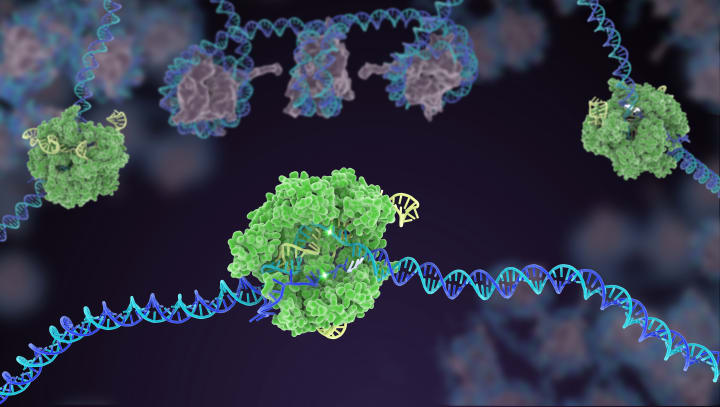Molecular Genetics- Basic.
Sub-topic: DNA, Genome, Genes, Inheritance, Mutations, Genetic Disease, PCR, CRISPER, ETC. — PART. 1 Bacteriophage (virus) and CRISPR Cas9- Part 2.

Sub-topic: DNA, Genome, Genes, Inheritance, Mutations, Genetic Disease, PCR, CRISPER, ETC. - PART. 1
Introduction
The blueprint of life is DNA; DNA contains the genetic information that is passed from parents to their offspring. This genetic information is in-coded by four letters A, T, G, and C in genes which is the basics for inheritance. Usually, A pairs with T and G with C; the four letters when paired are called base pairs. When there is a mismatch with any of the bases, it is referred to as a genetic mutation. There are several techniques a molecular geneticist employs to sequence a genome, identify an area of mutation, correct/ manipulate it, or find a therapy.
What is Molecular Genetics?
It is the scientific discipline that involves the study of genes, mode of inheritance, mutations, etc, at the molecular level. A molecular geneticist is an individual who studies molecular genetics.

What Is DNA?
DNA is deoxyribonucleic acid, it is a double-helical structure made of base pairs, A-T and G-C, on each strand held together by hydrogen bonds; DNA is referred to as the tree of life because it contains the genetic blueprint from which all organisms exist and inherits that which makes an organism unique.

Base Pairing
There are four main bases in DNA: Adenine(A), Thymine(T), Guanine(G), and Cytosine(C). There are about six billion of these letters found within a human's genome and there are about three billion base pairs. "A" pairs with "T" and "G" with "C"; hydrogen bonds hold base pairs together. A pyrimidine pairs with a purine; they have different structures, and they pair so that they fit perfectly well within the double helix of DNA.
NUCLEOTIDES
Nucleotides are a set of base pairs held together within a double DNA stand by a phosphodiester bond, it is this bond that forms and holds the backbone of DNA strands. Hydrogen bonds hold base pairs within DNA strands, although they are weaker, several hydrogen bonds holding base pairs within a DNA strand make the strand stronger.
DNA Replication
To make many copies of a DNA of interest, it has to be replicated; several techniques involve the replication of DNA, in this article, I would like to talk about Polymerase Chain Reaction (PCR). PCR involves the use of a prob, enzymes, a PCR machine, a primer, etc. The various steps involved are denaturation (separation), annealing (initiation), elongation (extension), and termination.
STEPS In PRC in Making Many Copies Of A DNA

1. Denaturation: The DNA strand of interest is placed within a PCR machine with a temperature of 95 degrees C for 20–30 seconds; at this temperature, the hydrogen bonds holding base pairs within the strands break thereby separating the double helix.
2. Annealing: The temperature of the PCR machine is lowered to 55 degrees C and a primer is added to each strand, from the 5 prime to the 3 prime of a single DNA strand. The temperature is lowered to enable the bonding of the primer to the initiation site of the single DNA strand.
3. Elongation: Required enzymes and bases responsible for elongation are added and the temperature of the PCR machine is increased to 75- 80 degrees C; primers move from the 5 prime to 3 prime on the single strand adding bases to form the double strands of DNA.
4. Termination: When the double strands are formed, the temperature is lowered, stopping the process. The steps are then repeated on the two new double strands until the required number of DNA strands are formed.

It refers to the entire genetic makeup of an organism; the entire genome of a human contains six billion letters and three billion base pairs. The human genome project carried out by renounced scientists from around the world led to the complete sequencing of the Human Genome.
What are Genes?
They are referred to as the basic units of inheritance; each gene contains a unique sequence of base pairs that identifies and gives it its unique function. Genes are made of DNA and most genes code for proteins. If there is a change within a gene thereby affecting its function, it is referred to as a mutation. A point mutation is when there is a single change within a letter of a base pair. It is the change within a DNA sequence that leads to genetic disease.
Inheritance

It is the passing on of genetic materials from both parents to their offspring; this is achieved through sexual intercourse. During sexual intercourse between a male and a female, a male ejaculates sperms which when all conditions are successfully met, a sperm fertilisers an egg to form a zygote. This zygote moves into the uterus and implants into its wall, it develops into a baby containing equal amounts of genetic materials from both parents; when a parent has a genetic disorder that can be inherited, the offspring might inherit this genetic disorder.
Bacteriophage (virus) and CRISPR Cas9- Part 2.

Introduction
Before we talk about CRISPR Cas9, let us understand bacteriophages and how bacterium immunity works against viruses. Bacteriophages are viruses that infect and kill bacteria; bacteria have developed unique mechanisms- just like CRISPR cas9- to protect themselves against bacteriophages. CRISPR Cas9 is a tool adopted from bacteria immunity and developed by scientists to modify an organism's genetic material or a gene of interest- it is one of the most common tools used in genetic engineering.
Bacteriophages (Virus)

Viruses are called particles because they are only alive when in a specific living organism; they are regarded as non-living things outside of a living host. Viruses invade their hosts by attaching their tails and injecting their genetic materials into them; the genetic materials of the invading virus hijack that of its living hosts to make many copies. At a certain concentration, level of the virus' genetic materials within the living host cells, a chemical called endolysin is released, bursting the host cells and releasing more new viruses. Bacteriophages are viruses that attack bacteria; a bacteriophage is specific to a bacterium.
CRISPR Cas9

CRISPR is the short form of Clustered Regularly Interspaced Short Palindromic Repeats and cas9 is a protein that acts as a molecular scissor to cut genetic materials; CRISPR cas9 is a form of bacteria immunity adopted and developed by scientists.
Bacteria have a way they defend themselves against bacteriophages; when a virus injects its genetic material into a bacteria, cas proteins in the bacteria attack, cut, and copy a section of the virus's genetic material. This cas protein together with the virus' genetic material cuts and fixes itself into the CRISPR region of the bacterial's genetic material creating a blueprint of the virus genetic material; several RNA copies of the CRISPR complex found within the bacterial's DNA are made.
This RNA CRISPR cas complex binds with a specific cas9 protein forming a CRISPR cas9 protein complex with the virus' genetic material; the RNA CRISPR cas9 protein complex continually moves within the bacteria scanning it for similar future virus invasion. When a similar virus invades the bacteria, the RNA CRISPR cas9 protein complex identifies and eliminates the invading virus thereby providing immunity to the bacteria.
Scientists in the laboratory have developed CRISPR cas9 to modify organisms and food crops for a desired purpose.

Author: Sekou Sesay



About the Creator
Sekou Sesay
Love






Comments
There are no comments for this story
Be the first to respond and start the conversation.